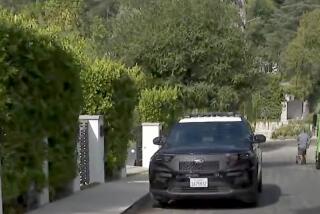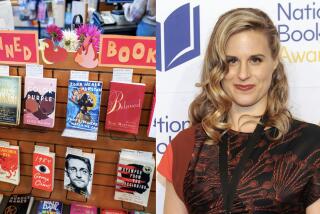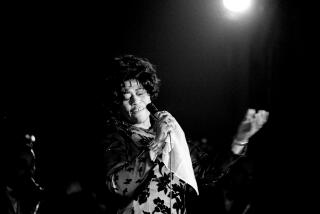Great Scott! Fitzgerald Was a Local
- Share via
The first thing you are aware of is the roar of the traffic.
Edward Everett Horton Lane runs uphill from Burbank Boulevard for one short block before it dead-ends at the Ventura Freeway. The nonstop music of the neighborhood is the sound of cars whizzing by.
Sept. 24 was the hundredth anniversary of the birth of F. Scott Fitzgerald, and I have come to Encino in search of his spirit.
Many communities lay claim to the author of “The Great Gatsby” and “Tender Is the Night,” including St. Paul, Minn., where he was born, and Asheville, N.C., where his widow, Zelda, tormented by mental illness, died in a hospital fire.
But, for a year and a half toward the end of his life, Fitzgerald was a genuine Valley guy, living in a two-story house on Belly Acres, the Encino estate owned by actor Horton. Always scrambling for money in those days, Fitzgerald paid a manageable $200 a month.
The home address that appeared on Fitzgerald’s correspondence, beginning in October 1938, was 5521 Amestoy Ave. That spot is now occupied by freeway (it’s in the the westbound lane, just west of the Balboa onramp, by best estimate). The closest surviving address is the Horton Lane apartments at 5533. Unfortunately, they are securely locked up.
The street is quiet as cloister, except for the swoosh of the traffic, until David Bell comes along, walking his two toy poodles. Bell, 38, is a credit-card company representative, and, no, he doesn’t know of any famous writers having centenaries who ever lived in the neighborhood.
But he seems pleased to hear that F. Scott Fitzgerald once plied his writer’s trade here. It turns out that Bell, too, has literary aspirations. He’s no pro, he says, but he does write spiritual pieces for his church.
Once read by every American collegian, Fitzgerald made a spectacular debut with his first book, “This Side of Paradise,” published in 1920. A fictionalized account of his brief tenure as an undergraduate at Princeton University, that book is little read now but was wildly popular in its day. In subsequent years, William Faulkner and other contemporaries won literary prizes while Fitzgerald slid into obscurity.
In Encino, Fitzgerald did rewrites on the MGM epic “Gone With the Wind.” He wrote long letters to his beloved daughter, Scottie, back East at Vassar, telling her what courses to take at painful length. Once he had fellow writer John O’Hara to lunch. But mostly he sat on his bed with a pen, fitting word after well-chosen word, making a start on his unfinished Hollywood novel, “The Last Tycoon.”
Bell likes the notion that literature was made near this Valley cul-de-sac. “Maybe it’s in the air around this neighborhood,” he says, hopefully.
Back in Minnesota, St. Paul is celebrating Fitzgerald’s birthday by erecting a life-size statue of the man. The U.S. Postal Service is bringing out a Fitzgerald stamp.
The Encino years were quiet ones for Fitzgerald, who had once been a Jazz Age icon, as famous for drinking too much champagne and dancing in fountains as for his books. You can’t expect to find a life-size statue on Edward Everett Horton Lane, but it seems wrong that Encino isn’t celebrating its adoptive son in some fashion in this, his centennial week.
Maybe I’m looking in the wrong place. Where might Fitzgerald go if he still lived in the neighborhood?
The big Barnes & Noble on Ventura Boulevard is where. It has an adjacent Starbucks, for one thing. Fitzgerald was fighting the Creature hard when he lived here, going on a few spectacular benders but mostly keeping away from his nemesis, gin. At the coffee shop, he wouldn’t be tempted by anything stronger than a Rhumba Frappuccino.
At Starbucks three women are sitting at one of the tables. They look like women who read, and, indeed, two are in a book club that meets monthly.
“Do you know what famous writer lived on Amestoy?” I query. “Give us a clue,” they counter. A minute later, they are smiling at the thought of sharing a community with the creator of Jay Gatsby.
“I bet he would have gone to that place with the ducks, Lake Encino--that’s within walking distance of Amestoy,” Mindy Cahan speculates.
“I can’t believe he lived in Encino,” says Doreen Nortman. Both her son and daughter go to Princeton, which Fitzgerald dropped out of to avoid flunking out. She has always identified him with that New Jersey community, not her own.
In the bookstore, only one customer is in the aisle where Fitzgerald’s works are for sale. A literature major, 27-year-old Randi Kagan read all four of Fitzgerald’s novels in college, but she too is amazed to learn that he lived nearby.
“I love ‘The Great Gatsby,’ ” she says, praising Fitzgerald’s creativity and vision.
Contrary to legend, not all of Fitzgerald’s books were out of print when he died in 1940 at the age of 44. But he certainly wasn’t selling the way he does today. The last royalty check Fitzgerald lived to see was for $13.13. People now buy more than 350,000 copies of his books annually.
English major or no, in the week of Fitzgerald’s centennial, Kagan isn’t one of them.
She cradles two novels in her arm. “Don’t say what they are,” she pleads. “I’m going on a very long plane flight--to Argentina--and so I’m buying junk.”
No wonder the poor man drank.
More to Read
Sign up for our Book Club newsletter
Get the latest news, events and more from the Los Angeles Times Book Club, and help us get L.A. reading and talking.
You may occasionally receive promotional content from the Los Angeles Times.








